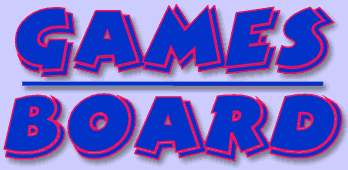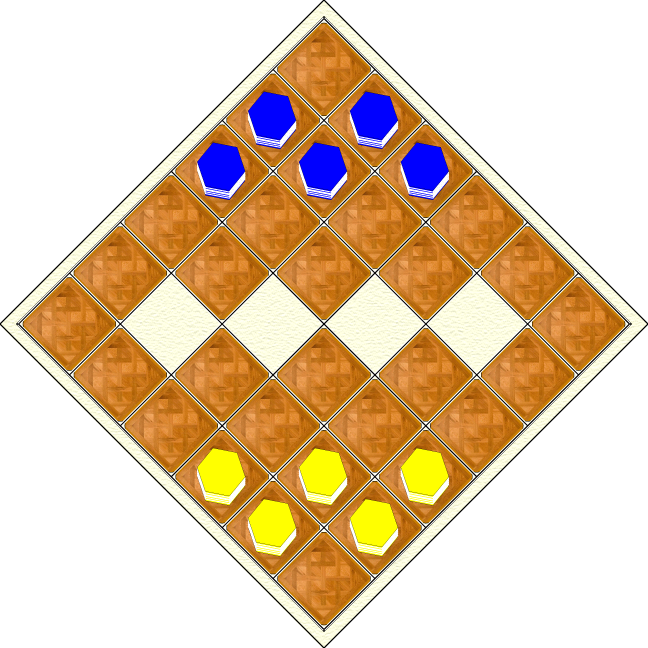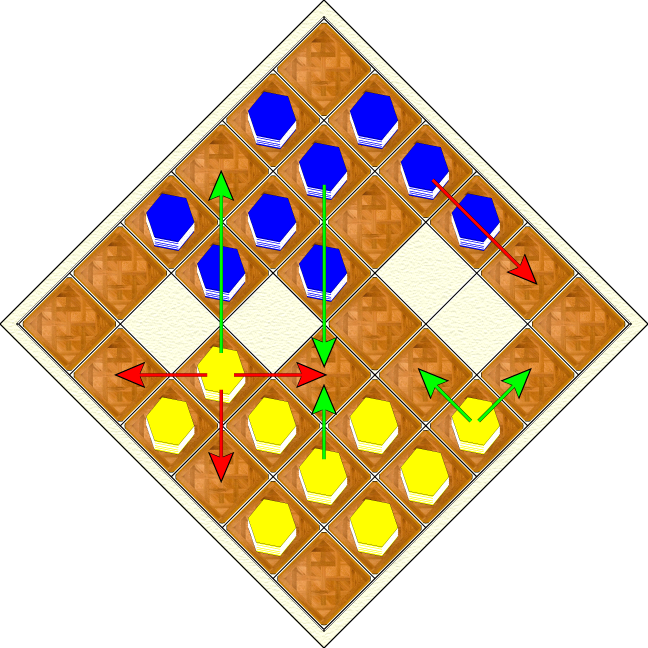
Parquet
Parquet

Games Above Board • Hijara • Rhumb Line • Rhumb Line iPhone App • Dead Man's Dice + Bandanas + T-Shirts • Games • E-mail
Games Above Board • Hijara • Rhumb Line • Rhumb Line iPhone App • Games • The Game's Up!
Dead Man's Dice + Bandanas + T-Shirts • MySpace • Wikipedia Hijara • Wikipedia Mozaic • Wikipedia Rhumb Line
Dead Man's Dice + Bandanas + T-Shirts • MySpace • Wikipedia Hijara • Wikipedia Mozaic • Wikipedia Rhumb Line
Parquet History
The word, 'parquet', derives from French 'parqueterie', the first known use was 1678.
Large diagonal squares known as 'parquet de Versailles' were introduced in 1684, as 'parquet de menuiserie' (woodwork parquet), to replace marble flooring.
In 1693, such parquet was noted by the Swedish architect Daniel Crontsröm at Versailles and the Grand Trianon.
The game, Parquet, is played with colored pieces on a board of geometrical and angular squares, in a mosaic of block patterns, of flooring-like wood tiles.
© 2011 MHS
The word, 'parquet', derives from French 'parqueterie', the first known use was 1678.
Large diagonal squares known as 'parquet de Versailles' were introduced in 1684, as 'parquet de menuiserie' (woodwork parquet), to replace marble flooring.
In 1693, such parquet was noted by the Swedish architect Daniel Crontsröm at Versailles and the Grand Trianon.
The game, Parquet, is played with colored pieces on a board of geometrical and angular squares, in a mosaic of block patterns, of flooring-like wood tiles.
© 2011 MHS
Parquet is a 2-player abstract strategy board game of movement and stacking.
COMPONENTS:
Square game board with 32 square sliding tiles in a 6-by-6 grid, 5 blue pieces, 5 yellow pieces, bag, rules.
Players begin the game with 5 pieces of their chosen color.
OBJECT:
Stack three own-color pieces on the rear-rank corner tile of the opponent.
SETUP:
The pieces are placed in the bag and the first player to draw their own color will start
the game.
The game board comprises 6 rows (ranks) and 6 columns and is positioned between
the players in a diamond orientation.
Note: game board orientation does not affect ‘diagonally / orthogonally’.
The tiles are placed on the board leaving the 4 center spaces void in a
horizontal row.
The rear corner tile is left empty and the pieces are positioned on tiles in
rows of 2 and 3.
MOVEMENT:
A piece is moved in an advancing direction to an unoccupied adjacent tile or,
it may leap diagonally over another piece to an unoccupied tile immediately beyond.
Players alternately either move or leap one piece at a time to an unoccupied tile then
slide an unoccupied tile orthogonally to an adjacent void ... or, slide an unoccupied tile
orthogonally to an adjacent void then move or leap a piece.
UNOCCUPIED TILE EXCEPTION:
A piece may move or leap to the occupied rear-rank corner tile of the opponent (to form a stack).
A piece may not move onto or leap over a void.
Players may not return their last piece moved, or the last tile moved, to its immediately previous position.
A player unable to move/leap a piece or slide a tile, forfeits the turn.
The first player to stack 3 of their pieces on a tile in the rear corner on the opponent’s side of the board
is the winner.
MOVES: 'advancing direction' = to any of the 3 possible / available tiles forward of the tile the piece is on.
See example: green arrow moves are advancing and allowed, red arrow moves are not allowed.
Green is go, red is no!
COMPONENTS:
Square game board with 32 square sliding tiles in a 6-by-6 grid, 5 blue pieces, 5 yellow pieces, bag, rules.
Players begin the game with 5 pieces of their chosen color.
OBJECT:
Stack three own-color pieces on the rear-rank corner tile of the opponent.
SETUP:
The pieces are placed in the bag and the first player to draw their own color will start
the game.
The game board comprises 6 rows (ranks) and 6 columns and is positioned between
the players in a diamond orientation.
Note: game board orientation does not affect ‘diagonally / orthogonally’.
The tiles are placed on the board leaving the 4 center spaces void in a
horizontal row.
The rear corner tile is left empty and the pieces are positioned on tiles in
rows of 2 and 3.
MOVEMENT:
A piece is moved in an advancing direction to an unoccupied adjacent tile or,
it may leap diagonally over another piece to an unoccupied tile immediately beyond.
Players alternately either move or leap one piece at a time to an unoccupied tile then
slide an unoccupied tile orthogonally to an adjacent void ... or, slide an unoccupied tile
orthogonally to an adjacent void then move or leap a piece.
UNOCCUPIED TILE EXCEPTION:
A piece may move or leap to the occupied rear-rank corner tile of the opponent (to form a stack).
A piece may not move onto or leap over a void.
Players may not return their last piece moved, or the last tile moved, to its immediately previous position.
A player unable to move/leap a piece or slide a tile, forfeits the turn.
The first player to stack 3 of their pieces on a tile in the rear corner on the opponent’s side of the board
is the winner.
MOVES: 'advancing direction' = to any of the 3 possible / available tiles forward of the tile the piece is on.
See example: green arrow moves are advancing and allowed, red arrow moves are not allowed.
Green is go, red is no!

